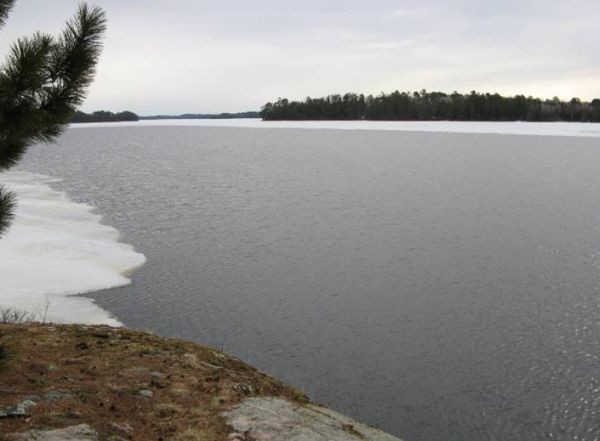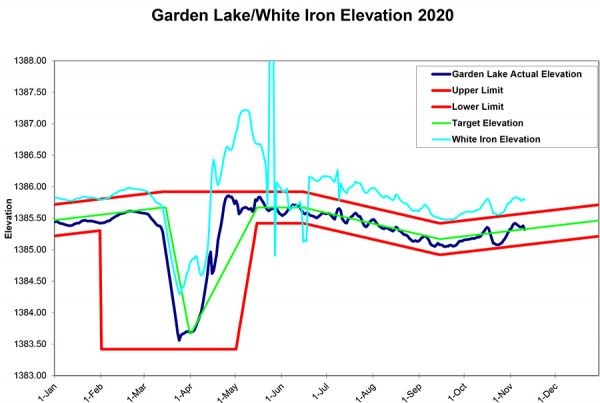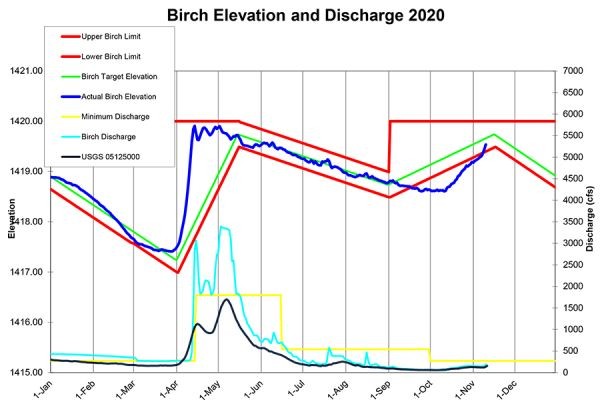Check out this article on the 1988 Mother’s Day Fire and how to be prepared for wildfires...
White Iron Chain Of Lakes Association
Winton Hydroelectric Project
Federal Energy Regulatory Commission License Settlement Agreement
On October 28, 2020 Minnesota Power hosted the annual meeting of the parties to the Winton Federal Energy Regulatory Commission (FERC) License Settlement Agreement, including Minnesota Power, Minnesota Department of Natural Resources (DNR), Minnesota Pollution Control Agency, U.S. Forest Service, White Iron Chain of Lakes Association (WICOLA), and Conservationists with Common Sense. The purpose of the annual meeting is to discuss the hydroelectric project operations and ensure compliance with the FERC License and associated Settlement Agreement.
Each year Minnesota Power contributes money to the funds held and managed by the U.S. Forest Service and Minnesota DNR to be used for biological, recreation, and erosion projects. Those agencies reported the following contributions for 2020:
· WICOLA received $2,000 from the Biological fund for water monitoring.
· The US Forest Service received $51,850 from the Recreation Fund for two new accessible outhouses at Birch Lake Campground and material and supplies for the South Kawishiwi Pavilion.
In addition to discussing the Settlement Agreement, the parties are also able to share information about recreation, historic properties, erosion, biological, and water quality projects in the area. Below are a few of the topics discussed:
· The National Park Service and the North Country Trail Association are considering routing the North Country Trail through the Winton area.
· Thin Ice signs were placed in 2020 and will be up again in 2021 for the snowmobile trail on White Iron Lake. St. Louis County Search and Rescue did some training there.
· Minnesota DNR reported that White Iron Lake had average walleye counts and some big northern pike. Birch Lake Reservoir had high walleye numbers but smaller in size. Cisco numbers were good. The reports will be published on the Minnesota DNR Lakefinder website.
Minnesota Power provided graphs of the 2020 water levels and discharges. Birch Lake Reservoir fell below the allowable operating band in September due to drought conditions. The group discussed the elevation of White Iron Lake which is not directly regulated by Minnesota Power. Some people commented that White Iron Lake was lower than normal in the late summer and fall. MN Power explained that this was in part due to the lower flow in the system because of the drought and that Garden Lake Reservoir is slowly drawn down from mid-June to mid-September each year. Birch Lake Reservoir returned to within the allowable operating band by November 10, 2020. The graphs below show the planned and actual lake elevations for Birch, Garden and White Iron Lakes during 2020. See https://www.mnpower.com/Environment/Hydro for more information on water levels and discharges.
Upcoming Webinar: Small Synthetics II - An update on a Study of Microplastics in Minnesota's Inland Waters, including White Iron Lake
Where: Comfort of own home, via Zoom
When: Thursday, January 21st from 9 a.m. to 10 a.m.
Registration is required: https://umn.zoom.us/webinar/register/WN_gHM8izL2Tqmnf6xulxMzjg
Presentation Summary: This webinar is the second in a series about microplastics research in Minnesota lakes. Dr. Kathryn Schreiner and master's candidate Peter Conowall will provide a research update on the project.
Microplastics are very small plastic particles, less than 5 millimeters (or 1/20th of an inch) in size. They come from common items such as degraded plastic bags, synthetic clothes and textiles, and some hygiene products. They are found across terrestrial, aquatic, and marine environments worldwide. These particles are speculated to negatively impact the aquatic environments and ecosystems; however, it is not known with certainty where these particles are in aquatic environments. Research is currently being done to learn how much and what kinds of microplastics are found in four Minnesota sentinel lakes: Peltier, Elk, White Iron, and Ten Mile. Additionally, the research project is designed to engage community members in part of the research process and communicate about microplastics and project results. So far, plastics have been found in the waters and on the bottom of the lake in the sediment of all four study lakes. In the fall of 2020, researchers will begin dissecting two types of fish to see if there are any plastics in their guts: 1) filter feeders (cisco) and 2) visual feeders (bluegill and perch). Fish will be collected by the research team and also by community members who are interested in collaborating on the project. Anglers can submit fish stomachs throughout the year for research staff to dissect and analyze for any microplastic consumption. More details, including how to join our citizen scientist team, can be found on our project website: www.mnplastics.org
More about the project: The Legislative Citizen-Commission on Minnesota Resources (LCCMR) funded the two year long microplastics project in 2019, and it concludes 2021. The microplastics project team is led by Dr. Kathryn Schreiner, a researcher from the University of Minnesota Duluth (UMD), and comprises additional researchers from UMD, the Sentinel Lakes program coordinator from Minnesota Department of Natural Resources, and an extension staff from Minnesota Sea Grant. Questions about the project can be directed to: Dr. Kathryn Schreiner,
Did you miss the first webinar? You can find a link by visiting www.mnplastics.org and clicking on the "Small Synthetics" link on the web page.
Can't make it? No problem. The presentation will be recorded and available at www.mnplastics.org
Results of the 2020 Watercraft Inspections on the White Iron Chain of Lakes
- Throughout 2020, North St. Louis and Lake County Soil and Water Conservation Districts (SWCDs) conducted watercraft inspections at various public landings on the White Iron Chain of Lakes, and lakes that drain into or "feed" White Iron Chain of Lakes. Inspectors checked boats for attached organic matter and water and educated public access users of the risk Aquatic Invasive Species (AIS) pose to our lakes and how to help prevent their spread.
- Fall, Birch-South, Farm, and White Iron-North boat landings were the busier places on the Chain of Lakes and feeder lakes.
- 0 to 2.6% of the boats inspected at Chain of Lakes and feeder lakes boat landings had plants or animal species attached. About 4-6% of the boats inspected at Kawishiwi River campground, Moose Lake, and northeast Bear Island boat ramps had plants or animal species attached.
- Due to COVID-19, inspector trainings were moved to an online platform rather than in-person. This reduced the funds needed for training, and therefore North St. Louis SWCD was able to allocate an additional 100+ inspector hours to better cover the Birch-South boat ramp which was particularly busy. In total, between North St. Louis and Lake County SWCDs, 777 inspector hours were worked on White Iron Chain of Lakes, and 256 inspector hours were worked on feeder lakes.
- Although traffic was low on the smaller lakes, inspectors found people on those lakes move from one lake to another lake more often than those who visit bigger lakes in the region. Lake hopping raises the risk of lakes acquiring a new infestation.
- In June, North St. Louis County SWCD was able to acquire Decon Goal signs and these helped encourage complete decontaminations and helped visualize the social norm of receiving a decontamination. Decontaminations use hot water to kill attached AIS, and flush out water from live wells, so that a watercraft can enter a waterbody without introducing a new infestation.
- White Iron Chain of Lake Association is working hard to maintain water quality and healthy lake ecosystems by preventing the spread of AIS.
Tuesday Group Zoom Meeting; 12 Noon to 1PM
Sept 1 - Jeff Pike, President of WICOLA - White Iron Chain of Lakes Association
Jeff plans to cover background on WICOLA, their priorities, and talk about the water quality program on the White Iron Chain.
To Join the Tuesday Group Meeting;
https://us02web.zoom.us/j/89631918520?pwd=UHRYMkRCMnN2aUR2M3NnbFNsS3pLdz09
The meeting ID is 896 3191 8520
Pass Code is 497 568
Paul Schurke is an Outdoor Educator, an Arctic Explorer, a Disability Rights Advocate, Environmental Advocate with Save the Boundary Waters, Proprietor of Wintergreen Dog Sledding Lodge, and a WICOLA Member.
The following History Notes of our area were collected by Paul Schurke.
Found in most fishing jigs and sinkers, lead poisons wildlife including loons, eagles, and other waterfowl. Switching from lead weights and sinkers to those made from tin, steel, bismuth, and other materials protects our state bird when they inadvertently swallow lost tackle while scooping up pebbles to help grind their food. Research around the nation has found that poisoning from lead fishing tackle is responsible for 12 to 50 percent of adult loon deaths.
Help our Loons by checking out this important 2020 program.....
GET THE LEAD OUT!
A sweepstakes project from the MPCA- MN Pollution Control Agency
The WICOLA Annual Meeting will be held online at 4:00 pm, Thursday August 6th. You will be able to either call in or participate online with Zoom if you have preregistered to receive the call/log-in information.
The following are meeting handouts that can be downloaded;
- 2019 Annual Meeting Draft Minutes 2019_08_01-Draft-Annual-Meeting-Minutes
- 2020 Annual Meeting Financial Reports WICOLA---2020-Annual-Meeting---Finance-Report
- 2020 President’s Report WICOLA---2020-Presidents-Report
Microplastics are very small plastic particles, less than 5 millimeters (or 1/20th of an inch) in size. They come from common items such as degraded plastic bags, synthetic clothes and textiles, some hygiene products, and cigarette filters. Research is currently being done to learn how much and what kinds of microplastics are found in four Minnesota sentinel lakes: Peltier, Elk, White Iron, and Ten Mile. So far, plastics have been found in the waters and on the bottom of the lake in the sediment of all four study lakes.
In the fall of 2020, researchers will begin dissecting two types of fish to see if there are any plastics in their guts: 1) filter feeders (cisco) and 2) visual feeders (bluegill and perch). Anglers can submit fish stomachs throughout the year for research staff to dissect and analyze for any microplastic consumption.
White Iron Lake Angler Volunteers Urgently Needed
The Research Team is ready to receive fish stomachs from anglers who want to contribute to the project! They are looking for anglers who can commit to sending 10 fish gut samples from White Iron Lake in 2020. Additional information on how to process, including stomach & intestine removal noting how to keep the organs intact, how to prepare and package for shipment, and where to ship samples is located at www.mnplastics.org in an easy how to video.
If people want a fish gut collection kit, they can inquire with Dr. Schreiner at
Samples are mailed to: Large Lakes Observatory, 2205 E 5th St., Duluth MN 55812.
More about the project: The Legislative Citizen-Commission on Minnesota Resources (LCCMR) funded the two yearlong microplastics project in 2019, and it concludes 2021. The microplastics project team is led by Dr. Kathryn Schreiner, a researcher from the University of Minnesota Duluth (UMD), and comprised of additional researchers from UMD, the Sentinel Lakes program coordinator from Minnesota Department of Natural Resources, and an extension staff from Minnesota Sea Grant. Questions about the project can be directed to: Dr. Kathryn Schreiner,
Volunteers from across Minnesota are needed on Saturday, August 15, 2020 to participate in a statewide search for starry stonewort, one of Minnesota’s newest aquatic invasive species. Hundreds of volunteers will gather at local training sites to learn how to identify starry stonewort and other aquatic invasive species and search for them in area lakes.
Starry stonewort is an invasive algae that was first found in Minnesota at Lake Koronis in 2015 and has since spread to fourteen Minnesota lakes. Early detection of this species is critical for control. Starry Trek volunteers have found starry stonewort in three lakes – Grand Lake in Stearns County, Wolf Lake at the Hubbard/Beltrami County border, and Lake Beltrami in Beltrami County – as well as other aquatic invasive species like Eurasian watermilfoil and zebra mussels during this event.
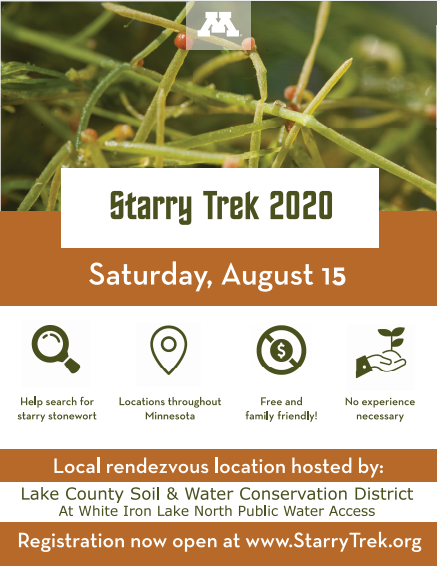
“This event is a terrific way for people to get outdoors, get educated about aquatic invasive species, and help protect their area lakes,” said Megan Weber, Extension Educator with the University of Minnesota and Minnesota Aquatic Invasive Species Research Center. “The information we gain at this event helps researchers and managers understand its current distribution and potentially take action if new infestations are found.”
No experience or equipment is necessary to participate in Starry Trek. Expert training on monitoring protocols and starry stonewort identification will be provided on-site. This event is free, but registration is required. Children under 18 must be accompanied by a parent or legal guardian. The event’s protocols have been modified to accommodate COIVD-19 precautions. To view all safety measures, visit the event’s website (www.starrytrek.org).
There are currently 24 local training sites committed around the state, including one at White Iron Lake in Lake County.
“We’re excited to be partnering with the Minnesota Aquatic Invasive Species Research Center on this event for our third year,” said Liz Anderson, AIS Program Coordinator with Lake County SWCD. “Protecting our lakes for future generations is really important to us all, and we want to do make sure we’re doing the best we can to prevent the introduction and spread of AIS.” “We’ll start the day with a socially distant, outdoor plant ID training and then disperse to area pubic water accesses for surveying.”
Please register early as Covid-19 protocols require us to close registration after August 6. You can register at www.starrytrek.org
The Minnesota Aquatic Invasive Species Research Center works across the state to develop research-based solutions that can reduce the impacts of aquatic invasive. A portion of the funding for this program is provided by the Environment and Natural Resources Trust Fund. Learn more at www.maisrc.umn.edu.
For statewide information, contact:
Megan Weber, Extension Educator Minnesota Aquatic Invasive Species Research Center
763-767-3874
For local information, contact:
Liz Anderson Lake County Soil & Water Conservation District
612-232-1306
By Kelli Saunders (with minor editing for style)
For many, the answer to this is “nothing” because there is often a very deep connection to water for those who have waterfront property. But, the question is really about what you should allow to come between you and your lake – literally.
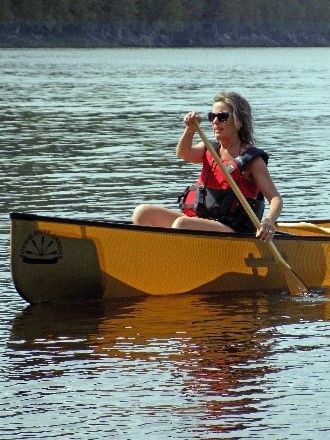 I was lucky enough to spend this last week out on Lake of the Woods in a favorite cabin, surrounded by trees, wildlife and, of course…water. I instantly felt a sense of calm and relaxation when I got there and as each day passed, a greater sense of respect and gratitude for this lake and its surroundings. For the most part, as I kayaked and canoed along the shoreline, I noticed many properties have kept a buffer of vegetation at the shoreline. They’ve kept things wild by letting the grass grow, letting the trees and shrubs stabilize their shoreline, minimizing the artificial structures and reducing disturbance. But, our lakes need everyone to do this, collectively, in order to have the biggest impact. Those who own waterfront property really do have a unique responsibility.
I was lucky enough to spend this last week out on Lake of the Woods in a favorite cabin, surrounded by trees, wildlife and, of course…water. I instantly felt a sense of calm and relaxation when I got there and as each day passed, a greater sense of respect and gratitude for this lake and its surroundings. For the most part, as I kayaked and canoed along the shoreline, I noticed many properties have kept a buffer of vegetation at the shoreline. They’ve kept things wild by letting the grass grow, letting the trees and shrubs stabilize their shoreline, minimizing the artificial structures and reducing disturbance. But, our lakes need everyone to do this, collectively, in order to have the biggest impact. Those who own waterfront property really do have a unique responsibility.
The zone from the water’s edge out to a depth of 7 feet is the most productive part of a lake and what happens upland of the shoreline can play a significant role in the health of that zone. One of the best lines of defence for property owners to consider are “buffers”, which are zones of natural vegetation at the shoreline that can help to keep the lake healthy. There are many benefits to maintaining a healthy buffer. Native plant buffers provide habitat for wildlife, including much needed pollinators, and supply shade for fish in that nearshore zone. The roots of trees and shrubs bind the soil and provide protection from erosion; if removed, the soil can easily be washed away with wave action and with that comes excess nutrients entering the lake. Buffers act as a sponge, soaking up nutrients in the runoff from upland areas – the roots utilizing the nutrients before they hit the water. Reducing nutrients in the first place can be done by eliminating the use of fertilizers and, if you do have areas where you cut the grass, ensure the clippings don’t end up in the lake. There are a few other great options to reduce the amount of runoff entering the lake, including installing rain barrels, creating rain gardens, minimizing pavement or other hard surfaces, making your path to the lake meandering instead of straight, and adding habitat islands (islands of trees and shrubs if you have a landscaped yard).
Research has shown that increased water clarity/quality can positively impact property value. While this shouldn’t be the sole reason for contributing to the health of the lake, it can be an important one. Being able to swim and fish and utilize the water from the lake are very good reasons for every shoreline property owner to be a good water steward and respect the connection between what they do on the land and how the water will respond to those decisions.
This series is provided as part of the International Watershed Coordination Program of the Lake of the Woods Water Sustainability Foundation (www.lowwsf.com).
Kelli Saunders, M.Sc., is the International Watershed Coordinator with the Lake of the Woods Water Sustainability Foundation
Microplastics are very small plastic particles, less than 5 millimeters (or 1/20th of an inch) in size. They come from common items such as degraded plastic bags, synthetic clothes and textiles, some hygiene products, and cigarette filters. They are found across terrestrial, aquatic, and marine environments worldwide. These particles are speculated to negatively impact the aquatic environments and ecosystems, however, it is not known with certainty where these particles are in aquatic environments. Research is currently being done to learn how much and what kinds of microplastics are found in four Minnesota sentinel lakes: Peltier, Elk, White Iron, and Ten Mile. Additionally, the research project is designed to engage community members in part of the research process, and communicate about microplastics and project results. So far, plastics have been found in the waters and on the bottom of the lake in the sediment of all four study lakes. In the fall of 2020, researchers will begin dissecting two types of fish to see if there are any plastics in their guts: 1) filter feeders (cisco) and 2) visual feeders (bluegill and perch). Fish will be collected by the research team and also by community members who are interested in collaborating on the project. Anglers can submit fish stomachs throughout the year for research staff to dissect and analyze for any microplastic consumption. More details, including how to join the citizen scientist team, can be found on the project website: www.mnplastics.org
Webinar scheduled for July 13th at 9 a.m. The research team will be hosting a webinar to provide updates and talk about the opportunity for anglers to participate in sample collection. Anyone who is interested in learning more about microplastics in Minnesota lakes is welcome to attend. Again, White Iron will be one of the featured lakes.
Title: Small Synthetics - A Study of Microplastics in Minnesota’s Inland Waters
Where: Comfort of own home, via Zoom
When: Monday, July 13th from 9 a.m. to 10 a.m.
Registration is required: https://umn.zoom.us/webinar/register/WN_3LfTRmHmRbG1h0OKNLcGEA
Can't make it? The presentation will be recorded and available at www.mnplastics.org
Community (citizen) science: The Research Team is ready to receive fish stomachs from anglers who want to contribute to the project! They are looking for anglers who can commit to sending 10 fish gut samples from one of the four project lakes (White Iron, Elk, Ten Mile, and Peltier) in 2020. Additional information on how to process and where to ship samples is located at www.mnplastics.org. If people want a fish gut collection kit, they can inquire with Dr. Schreiner at
More about the project: The Legislative Citizen-Commission on Minnesota Resources (LCCMR) funded the two yearlong microplastics project in 2019, and it concludes 2021. The microplastics project team is led by Dr. Kathryn Schreiner, a researcher from the University of Minnesota Duluth (UMD), and comprised of additional researchers from UMD, the Sentinel Lakes program coordinator from Minnesota Department of Natural Resources, and an extension staff from Minnesota Sea Grant. Questions about the project can be directed to: Dr. Kathryn Schreiner,
By Kelli Saunders (with minor editing for style)
Last November, I talked about “fall turnover”, a phenomenon that happens on our lakes here in northwestern Ontario when things cool off and the temperature and density of water changes, resulting in the mixing of top and bottom water layers that have developed over the summer (thermal stratification). As soon as the ice goes out, “spring turnover” takes place, once again mixing the waters of the lake from top to bottom.
During the winter, ice cover on a lake eliminates the impact wind has on the water’s surface. This essentially puts a lid on the chances for any further oxygen to be mixed into the water, which is critical for living organisms. So, all winter, organisms have a set amount of oxygen to survive on under the ice. Spring turnover is a welcome relief! Once the ice is gone, wind can blow across the water surface again and start to reoxygenate the lake. After ice out, the water will reach a point where the temperature (and, therefore density) is the exact same throughout the entire lake. Because of this, a persistent wind can mix oxygen into the whole lake – right down to the bottom and this is a crucial mechanism for replenishing dissolved oxygen levels in the lake. When the lakes are a uniform temperature and density, it takes relatively little wind energy to mix water deep into the lake. As new life emerges in our lakes in the spring, there is an increased need for oxygen and this process really does provide what is needed to support that new life and rejuvenate the organisms that survived over winter.
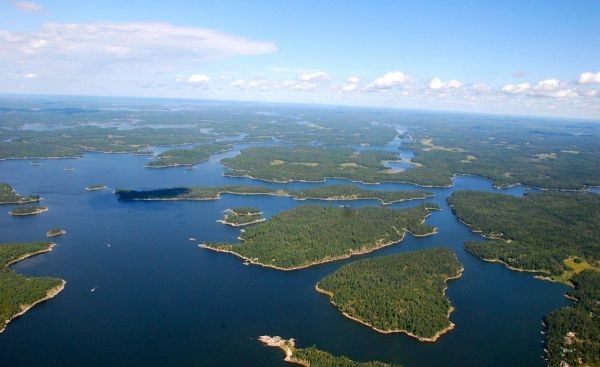 As the season progresses and surface waters warm, thermal stratification sets in with warm, less dense waters floating on top of the deep cold waters, with little mixing between the layers. Whatever dissolved oxygen there is in the deepest parts of the lake is all that is available until lake turnover once again, in the fall. Nature is truly amazing.
As the season progresses and surface waters warm, thermal stratification sets in with warm, less dense waters floating on top of the deep cold waters, with little mixing between the layers. Whatever dissolved oxygen there is in the deepest parts of the lake is all that is available until lake turnover once again, in the fall. Nature is truly amazing.
This series is provided as part of the International Watershed Coordination Program of the Lake of the Woods Water Sustainability Foundation (www.lowwsf.com).
Kelli Saunders, M.Sc., is the International Watershed Coordinator with the Lake of the Woods Water Sustainability Foundation.
Like every organization, WICOLA must make changes dealing with the COVID-19 situation. The annual meeting and elections are one of those changes. The WICOLA board sent out a poll to our members outlining five options ranging from business as usual, abbreviation meetings, to no meeting. Many of you responded and provided our board with your thoughts. We appreciate your input.
Your WICOLA board decided we will hold our August 6th Annual Meeting using an online or phone call-in format. You can call in by phone or log in on-line. Handouts will be available to download before the meeting. Our speaker, Dr. Euan Reavie, Senior Research Associate, will be providing a program online for the meeting. Elections will be held by mail. The following form is like what we will used for elections. We will soon be providing more information on how to log on by phone, internet, and to download exhibits and handouts. We will send out more information closer to the August 6th date. Voting Proxies will be sent out by U.S. Mail.
Sample Proxy and if you have not paid your membership do so now so you can vote.
WICOLA Proxy – one vote per membership (household).
President
___ Jeff Pike ___ Other (write-in):
Vice President
___ Other (write-in):
Garden Lake Representative
___ Sarah Kingston ___ Other (write-in):
West White Iron Lake Representative
___ Other (write-in):
I am a current WICOLA member with paid for membership for 2020 and have the authority to vote.
Signature ______________________________ Date _________________
Email to
Nominations – Want to be more involved in WICOLA?
We are always looking for help with the many things at WICOLA. We Nominating Committee is looking for members to fill the Vice President and one of the White Iron Lake Representative positions. If you think you may be interested, please contact any of our board members and they will be happy to discuss the position and their experiences. Also, if you want to be involved in other positions let us know.
By Mike Moen, Public News Service - MN
May 22, 2020
ELY, Minn. - Late May signals the start of boating season in Minnesota, which includes one of the world's most well-known wilderness areas. But with the threat of aquatic invasive species, a new coalition is working to protect the Boundary Waters.
This collection of lakes in northern Minnesota has largely been spared from infestation, but it could be only a matter of time before that changes. Jeff Forester, executive director of Minnesota Lakes and Rivers Advocates, says several organizations and agencies have jurisdiction over the area, which can leave gaps.
He hopes this effort will close those gaps.
"The coalition has come together and it's using a civic-organizing approach," says Forester. "So, we're organizing people to help protect the Boundary Waters."
In addition to state, federal and tribal governments, the coalition includes civic groups and local residents.
The Minnesota Department of Natural Resources says invasive species have been found in more than 1,100 waterways across the state. And while there have been some positive signs in lessening the impact, some worry the problem runs deeper.
In the Boundary Waters, only the spiny water flea has been detected.
In Minnesota, lake associations play a big role protecting waterways from infestation, assisting with things like boat inspections. But there aren't large associations in the Boundary Waters.
Matthew Santo, AIS tech with the 1854 Treaty Authority, says it can be a challenge getting the message through to boaters.
"One of the main projects we're focused on is increasing signage at the boat launches," says Santo, "just to give people information about invasive species, the risks involved."
Jeff Pike, a Boundary Waters-area resident who is part of the coalition, says while the groups involved have some competing interests, at the end of the day...
"We're all stewards of our lands, no matter where we're at," says Pike. "And the right thing is to try to keep the environment that we're in from being disrupted, and changed from external negative forces. And so, AIS falls right in there."
The coalition holds monthly meetings, conducted virtually right now because of the pandemic. An action plan is coming together that organizers hope will prevent any more infestations in the coming years.
For Immediate Release:
May 9th, 2020
Contact: White Iron Chain of Lakes Association:
White Bear Lake, MN - To celebrate Minnesota’s fishing opener, Wildlife Forever, along with the White Iron Chain of Lakes Association and leading fishing, boating and conservation groups proclaim Saturday, May 9th as Clean Drain Dry Day. The Conservation Proclamation highlights the importance of fishing and boating and how invasive species are a direct threat to lakes, rivers and local economies. Simple Clean Drain Dry steps are the best ways to prevent the spread but it’s up to everyone to do their part.
New reports show fishing license sales are up by 41% compared to last year at this time. Clean Drain Dry Day serves as a great conservation reminder for new anglers and affirms that fishing and boating are great ways to enjoy the outdoors while socially distancing during the COVID-19 outbreak.
Proclamation partners include: Babe Winkleman Productions, B.A.S.S., CD3, Fishing League Worldwide, (FLW), Linder Media, Majk Solutions, Minnesota Lakes and Rivers Advocates, National Marine Manufacturer Association, National Professional Angler Association, Outdoor Sportsman’s Group, Pennaz Multimedia, Rapala, Recreational Boating and Fishing Foundation, Wildlife Forever, Wired2Fish.
“I’m proud to be joined by local and national leaders in recognizing the importance of invasive species prevention,” said Pat Conzemius, President and CEO of Wildlife Forever. “Get out, enjoy your local waters, give each other some space and remember to wear your mask when around others.”
“Invasive species are preventable if we all do our part to Clean Drain Dry, every time,” said Jeff Pike.
Wildlife Forever and WICOLA would like to remind all boaters and anglers of the MN DNR’s recommendations to maintain 6 feet of social distance at fuel stations, docks, on the water, fish with people in your household, and stay close to home this fishing opener. View the Conservation Proclamation here: https://www.wildlifeforever.org/wp-content/uploads/2017/05/MN-Clean-Drain-Dry-Day-Proclamation-Final-PDF-FINAL.pdf
Do your part this fishing and boating season: Clean Drain Dry all boats, trailers and gear. And remember to Trash Unused Bait or bring water from home to preserve minnows and leaches.
The Clean Drain Dry Initiative™ is a state and national campaign to educate outdoor recreational users on how to prevent the spread of invasive species. Coordinated messaging focuses on strategic content, marketing communications and outreach tools.
Working with partners, Wildlife Forever coordinates statewide public outreach and educational efforts to prevent the spread of invasive species. Local counties, lake associations, and tribal associations plan to send a strong Clean Drain Dry message in 2020. Highway billboards, television and radio PSAs, sidewalk boards, posters and handouts to the public have all been planned to share the message across the state. To learn how you can participate, contact: Dane Huinker:
About Wildlife Forever: Our mission is to conserve America's fish and wildlife heritage through conservation education, preservation of habitat and management of fish and wildlife. Wildlife Forever is a 501c3 non-profit dedicated to investing resources on the ground. Recent audits reveal that 94% of every dollar supports our award-winning conservation programs. Please, Join Today and learn more about the State-Fish Art Contest®, Clean Drain Dry Initiative™ and Prairie City USA® at www.WildlifeForever.org.
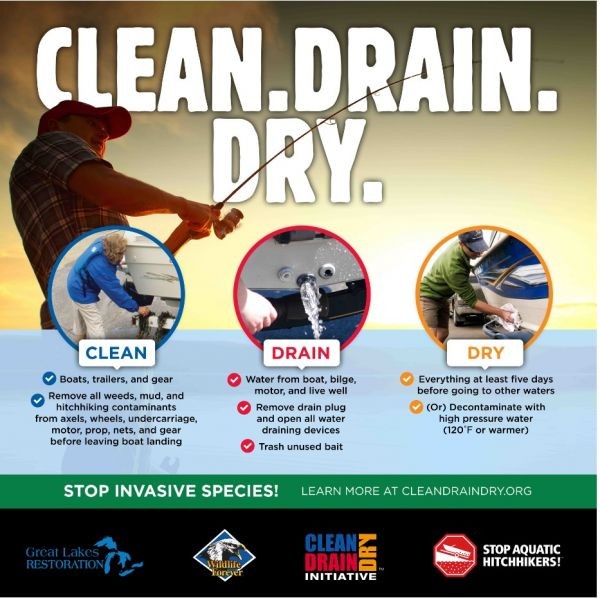
By Kelli Saunders (with editing for style)
We tend to hear more and more concern about invasive species, but what are they and how can we help prevent their spread? An invasive species is one that is not native to a specific location (an introduced species), and that has a tendency to spread to a degree believed to cause damage to the environment, economy or human health. Our watershed is vulnerable to introductions of non-native species, aquatic ones in particular, due to its proximity to other water systems and its popularity as a tourist destination. There are a wide variety of aquatic invasive species in our basin and nearby basins. These invasives impact our aquatic ecosystems by competing with native species for resources, such as food and habitat, and can destroy native fish spawning habitats. They are highly successful because they tend to not have any natural predators, they are highly adaptable, they reproduce very quickly and they thrive in disturbed systems. Various species of invertebrates have invaded waters through pathways that include recreational boating, bait bucket release, etc.
So….what can we do as boaters, anglers, resort owners or float plane operators to help prevent these invasions?
Did you know that if you put your boat in a lake that’s infested with an aquatic invasive species, you can threaten the health of the next lake you put your boat into if you don’t take precautions? This is one of the key vectors for the spread of invasives, but there are simple steps each of us can take to minimize the impact. Whether you are a recreational boater, an avid angler/tournament participant, a float-plane operator, a waterfowl hunter or a resort/campground owner, here are some helpful tips to keep in mind…simply, remember “Clean Drain Dry”:
- Clean all visible aquatic plants from your boat, trailer and equipment when
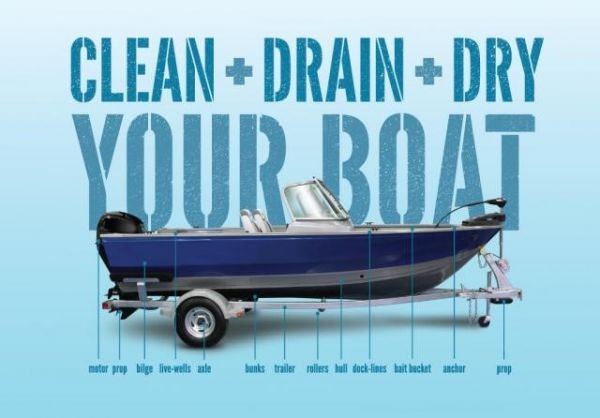 leaving a waterbody
leaving a waterbody - Inspect and clean your trolling motor as it can easily collect invasive animals and plant debris in shallow water
- If possible, pressure spray your boat and trailer and spray inside compartments with hot water, far from the water’s edge
- Drain your boat, ballast tanks, portable bait containers, motor, drain bilge, livewell and baitwell by removing drain plugs…upland, away from the water and before leaving the lake you were on; keep drain plugs out and water-draining devices open while transporting watercraft
- Allow your boat and equipment to dry in the sun as long as possible (5 days) before putting it into a different waterbody
- You cannot dispose of unwanted bait bucket contents into any waterbody. If using live bait, buy local. Unused bait, including night crawlers, should be put in the garbage. For more information on Minnesota Bait Regulations, go to; https://www.dnr.state.mn.us/fishing/regs
- Waterfowl hunters – clean plants and mud from your boat, motor, trailer, waders/hip boots, decoy lines, anchors, pushpoles and ATV
- For float plane operators, pump out floats into a sealable container and dispose upland
- Resort and campground owners, be sure your guests have helpful information available to them – pamphlets upon check-in or signs at your access points to alert customers to best practices
For more information go to; https://www.dnr.state.mn.us/invasives/ais/index.html
If you see an aquatic invasive species, take a photo, note your location, and report it to your local invasive species organization to help prevent their spread!
In Minnesota
- call 1-218-616-8102
- https://www.eddmaps.org/
Kelli Saunders, M.Sc., is the International Watershed Coordinator with the Lake of the Woods Water Sustainability Foundation.
WICOLA volunteers have reported official and unofficial “Ice Out” on our Chain of Lakes;
White Iron Lake; “Ice Out on April 30th”
Farm Lake; “Ice Out on May 1st”
Garden Lake; “Ice Out on May 1st”
Birch Lake*; “Ice Out on April 27th” *unofficial
Because of White Iron Lake’s diversity, White Iron is not called ice free until it is clear from the Silver Rapids Bridge to the public landing across the lake on Pine Road.
And for those that may be wondering how this year compares to previous years, the following are Ice Out for dates for White Iron;
2020 April 30th
2019 April28th
2018 May 7th
2017 April 14th
2016 April 20th
2015 April 17th
2014 May 12th
2013 May 14th
2012 March 25th
2011 April 29th
Let's go fishing, boating and canoeing while enjoying and preserving these wonderful waters we call “The White Iron Chain of Lakes”.
The following link provides some additional information from the DNR web site that reports the Earliest, Latest and Median dates that you may also find of interest.
https://www.dnr.state.mn.us/ice_out/index.html
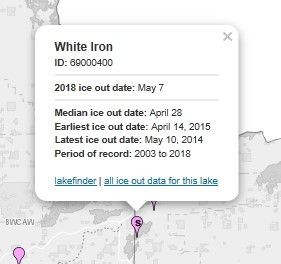
Birch Lake, Finn Bay, is edging towards Ice Out.
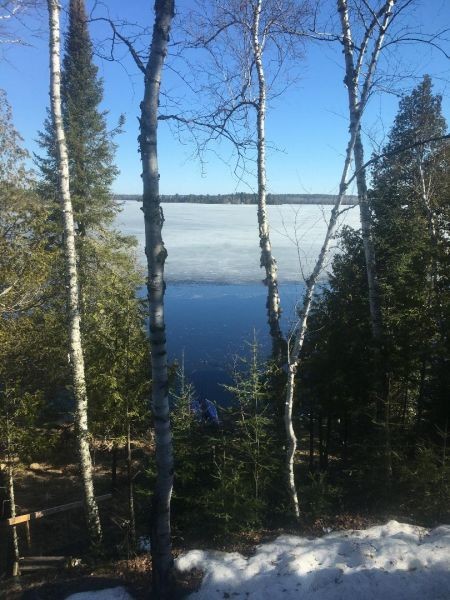
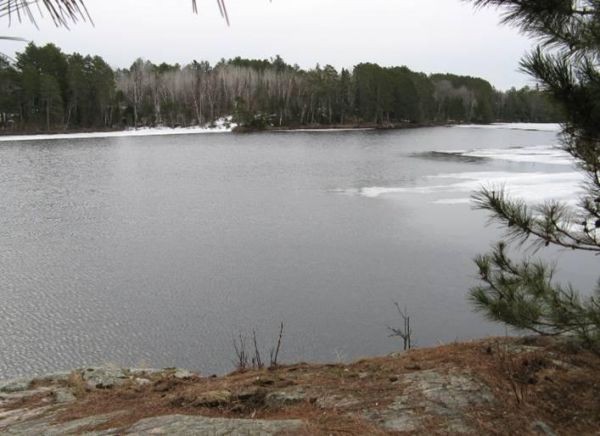 An April view of White Iron Lake.
An April view of White Iron Lake.
Hopefully Ice Out will be here soon.
